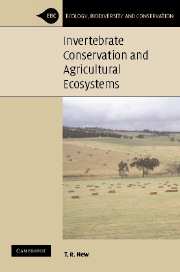Book contents
- Frontmatter
- Contents
- Preface
- Acknowledgements
- 1 Introduction: agricultural ecosystems and conservation
- 2 Agriculture and biodiversity: the place of invertebrates
- 3 Agriculture: effects on invertebrate diversity and conservation
- 4 Agricultural disturbance: diversity and effects on invertebrates
- 5 Biological control and invertebrate conservation
- 6 Cultural aspects of pest management
- 7 Extending beyond cropping areas
- 8 Field margins and landscape ecology
- 9 Pasture management and conservation
- 10 Towards more holistic management for invertebrates
- References
- Index
7 - Extending beyond cropping areas
Published online by Cambridge University Press: 29 July 2009
- Frontmatter
- Contents
- Preface
- Acknowledgements
- 1 Introduction: agricultural ecosystems and conservation
- 2 Agriculture and biodiversity: the place of invertebrates
- 3 Agriculture: effects on invertebrate diversity and conservation
- 4 Agricultural disturbance: diversity and effects on invertebrates
- 5 Biological control and invertebrate conservation
- 6 Cultural aspects of pest management
- 7 Extending beyond cropping areas
- 8 Field margins and landscape ecology
- 9 Pasture management and conservation
- 10 Towards more holistic management for invertebrates
- References
- Index
Summary
Impacts of crop protection measures can extend well beyond the immediate cropping areas. Cultural control strategies for pests in particular, increasingly incorporate considerations of the wider environment – especially the features of field margins. This chapter summarises aspects of these wider needs for enhancing habitat quality and re-creating natural habitats for invertebrates near agroecosystems and the need to consider these components as parts of a larger system for management and conservation. Detailed appraisal of the roles of boundary features such as hedgerows and headlands in Europe has helped to clarify many aspects of their roles as refuge habitats, barriers or dispersal corridors for numerous invertebrates, including natural enemies of crop pests.
Introduction
Aspects of cultural and conservation biological control extend well beyond the physical confines of the crop and can be important in integrating agricultural productivity with the wider landscape: ‘There is clear evidence that plants outside the cultivated field may provide the necessary resources to increase the impact of natural enemies’ (Ferro & McNeil, 1998). In particular, modifications to the physical structure and vegetational composition of field-margins and nearby areas have received considerable attention. As Wratten et al. (1998) noted, field-margin refugia (as well as within-field refugia, as noted in the last chapter) have substantial values in influencing the interactions between pests and their habitats and natural enemies. Wratten et al. recognised five main mechanisms relevant to considering these interactions, as follows:
the provision of overwintering or aestivating sites, or other, more temporary refuges;
the enhancement of the amounts and kinds of pollen and/or nectar available to sustain parasitoids and predators;
[…]
- Type
- Chapter
- Information
- Invertebrate Conservation and Agricultural Ecosystems , pp. 213 - 228Publisher: Cambridge University PressPrint publication year: 2005

